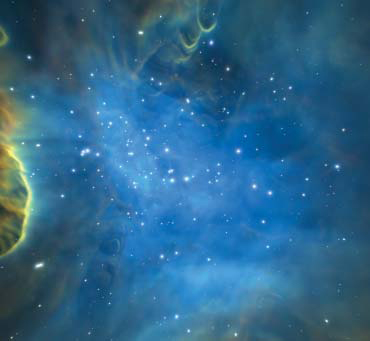Q. What is a 🌟 Star?
A star is a huge glowing ball of hot gas, mainly hydrogen and helium. Temperature is so high in its core that nuclear fusion occurs, producing energy. The outward pressure of gas heated by fusion is balanced by the inward pull of gravity, leaving the star in hydrostatic equilibrium. This balance of forces lasts for most of a star’s life, maintaining its steady temperature. Radiation and convection carry the energy from the core out through a star’s atmosphere. When the energy gets high enough in the atmosphere that the region above it is transparent, it escapes out into space as light of all wave- lengths, as well as stellar wind. Though stars may appear static, they rotate and vary in luminosity. There are hundreds of billions of stars in the Milky Way Galaxy alone. Among them is our Sun, the closest star to Earth.
Credit: John Chumack
Where do stars come from?
Every star forms in a huge cloud of gas and dust. Over time, gravity causes the cloud to contract, drawing the gas closer and closer together. As more gas accumulates at the center, it becomes denser and pressure increases. This causes it to heat up and begin to glow. Its gravity continues to pull in gas and dust, further increasing its mass, and thus its pressure and temperature. Eventually, the center reaches millions of degrees Celsius—hot enough to fuse hydrogen nuclei and generate intense energy. The heat generated by nuclear fusion causes the gas at the center of the star to expand, exerting an outward pressure. When hydrostatic equilibrium is reached, a star is born. Nuclear fusion powers the star until it eventually runs out of fuel and dies. Most stars form in tightly packed groups called star clusters, from which the majority are eventually ejected.
How do stars differ?
Though stars may look like similar points of light from our perspective on Earth, they actually differ from each other in many ways. Stars vary in their mass, size, temperature, color, luminosity, and age. They differ in their distance from Earth, and some orbit one or more other stars. They also change over the course of their lives. A star’s mass determines its temperature and luminosity, and how it will live and die. The more massive a star is, the hotter it burns, the faster it uses up its fuel, and the shorter its life is. The hottest and most massive stars are blue and bright, while the coolest and least massive stars are red and dim.
Why are stars important?
Without stars, we wouldn’t be here at all. At the beginning of the universe, the only elements that existed were hydrogen, some helium, and trace amounts of lithium. All other naturally occurring elements were formed during the life and death of stars. At the end of a star’s life, much of its matter is blown into space, where it provides the gas and dust for building new stars, planets, and everything on them including our bodies. Closer to home, when our Sun was born, its gravitational force held gas and dust in orbit, allowing for Earth’s formation. Now the Sun holds the planets in their orbits, heats the surface of Earth, drives Earth’s dynamic climate, and fuels photosynthesis.
How do scientists study stars?
We can see stars with the naked eye. But to observe them in detail, we depend on technology on the ground and in space. Ground-based telescopes enable scientists to see visible light, radio waves, and some infrared light. Satellites that orbit Earth, orbit the Sun, or journey through space allow scientists to observe light at all wavelengths, free from the blurring and obscuring effects of Earth’s atmosphere, and also enable them to sample the solar wind. In the lab, scientists conduct experiments to infer atomic and molecular properties of stars, and to investigate how nuclear fusion works. Finally, scientists use theoretical modeling and computer simulations to compute how the properties of stars (such as density, pressure, velocity, or composition) change over time.
Dhiraj Kumar



Comments
Post a Comment
Type Your Comment Here